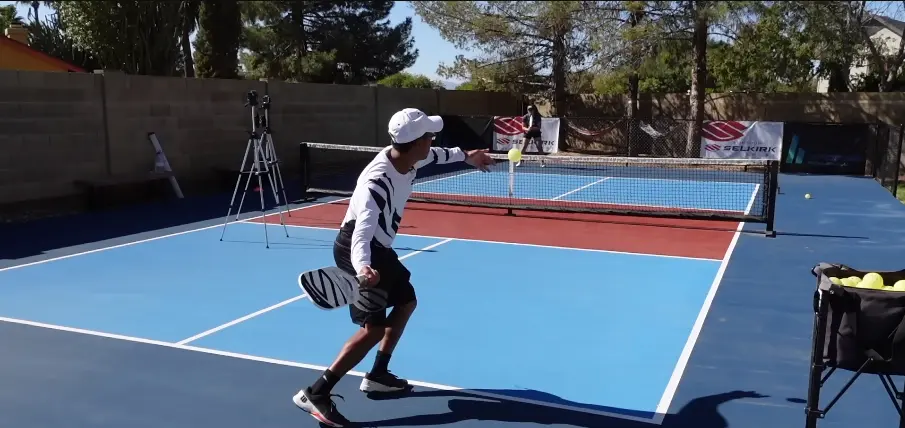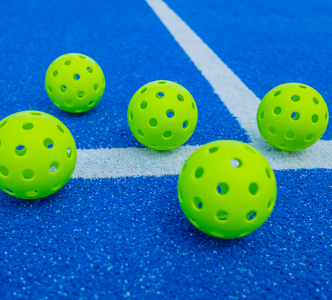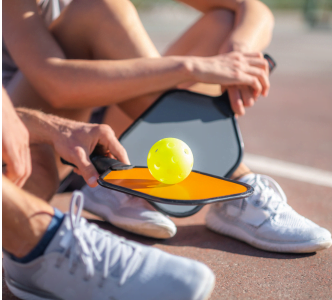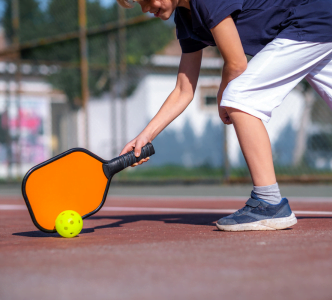Pickleball self coaching is all about practicing pickleball on your own, without a coach. Whether you’re a beginner, intermediate, or advanced player, sometimes you want to analyze your game and develop your skills by practicing alone at home.
This is where self-coaching becomes necessary if you’re looking to improve your game independently. We have shared the important skills and drills that will help you improve your pickleball game.
What You Will Learn in this Article?
- You will learn the importance of self-coaching for improving your pickleball skills.
- Learn the basics of self-coaching, including technique enhancement and footwork.
- Key skills like forehand, backhand, and serve, along with strategic thinking.
- Advanced techniques, like improving balance and dinking strategies.
Basic Skills for Pickleball Self Coaching
As I know for many beginners it’s hard to pay the pickleball lessons cost so that’s why self-learning is the best way to improve your skills. Before you can level up your play, building a solid foundation of fundamental pickleball skills is important.
These pickleball basics allow you more time to strategically place shots and move opponents out of position once the ball is in play.
Here are the key basics every pickleball player who wants to learn pickleball alone, should dedicate time to perfecting first:
Serving

Your serve starts the game, so getting it right is key. Most beginners begin with an underhand serve to keep the ball in play. As you get better, try more powerful forehand and backhand serves. When serving, focus on:
- Keeping the speed, height, and depth the same every time.
- Aiming your serves wide and deep into the corners.
- Mixing up where you serve to keep your opponent guessing.
To practice your serve alone, start close to the net to get better control. Then, step back little by little until you’re comfortable serving from the full-court distance.
Returning Serves
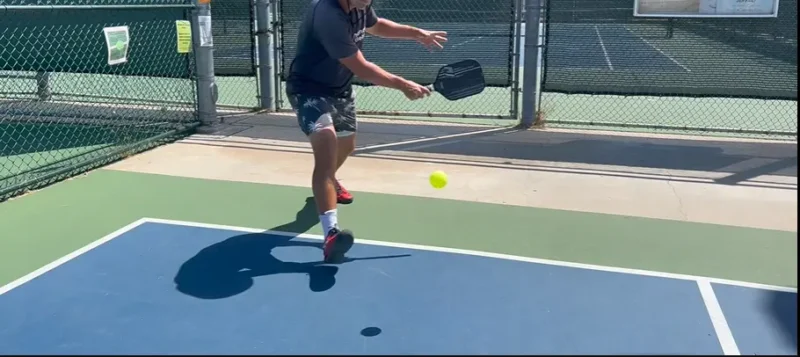
Great serves mean nothing if you can’t make a quality return! Work on your readiness position, footwork and reflexes by having someone serve to you in practice so you can react in real time. Key pointers for solid return serve include:
- Quick split step for momentum as the ball is served
- Effective backhand and forehand blocking against hard-hit serves
- Low returns aimed at the server’s feet to neutralize power
- Taking advantage of weaker second serves
Dinking
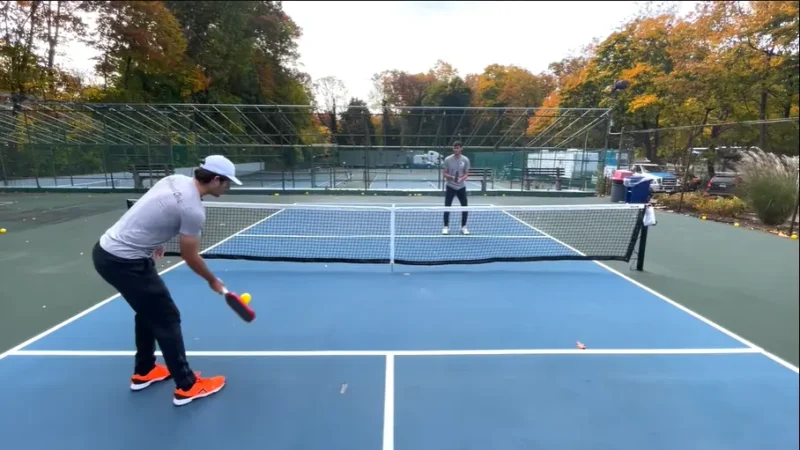
The dinking battle once the ball is in play often determines who wins the point. Dinking well requires blocking the ball softly with control, and setting up opportunities to strike decisively. Pay attention to:
- Keeping proper ready position centered at non-volley line
- Controlling speed, depth and height to neutralize opponents
- Strategic dink placement to move partner out of position
- Recognizing when the dinking rally has maxed out effectiveness before hitting out of exchanges
Spend time perfecting gentle dinks that clear the net with different heights, paces and angles. This extended rallying trains you to cover the court efficiently while probing for chances to take command of the point.
Footwork
Good footwork is crucial. It helps you move quickly and reach the ball in time. Here are some tips:
- Stay light on your feet: Keep moving so you can react fast to the ball.
- Use small steps: Big steps can slow you down. Take small, quick steps to move around the court.
- Practice side-to-side and front-to-back movements: These are the main moves you’ll use in a game.
- Work on your balance: Good balance helps you hit the ball better. Do exercises like lunges to improve your balance.
- Stay in a ready position: Keep your knees bent and your body ready to move in any direction
Third Shot Drop
The third shot drop is a key move in pickleball. It’s the shot you make after the serve and return. The goal is to hit the ball softly so it lands in the opponent’s non-volley zone, near the net. This forces your opponent to hit the ball upward, giving you a chance to move closer to the net. To practice the third shot drop:
- Aim for a soft, arcing shot that just clears the net.
- Focus on placing the ball close to the net in your opponent’s non-volley zone.
- Practice this shot from different distances to get comfortable with the right touch and control.
The third shot drop can give you a big advantage in the game, It helps you to take control of the net and set up winning shots.
Key Skills in Pickleball Self-Coaching
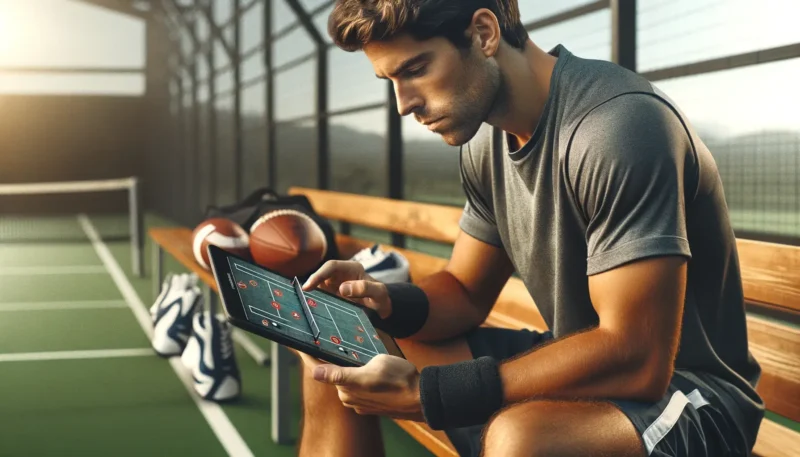
- Forehand: This is your go-to shot for power and control. Focus on a smooth swing and follow through, aiming to hit the ball at the peak of its bounce.
- Backhand: Often trickier than the forehand, a solid backhand is essential for a well-rounded game. Practice keeping your paddle face open and your wrist firm.
- Serve: A reliable serve starts the game on your terms. Work on placing your serves with precision, varying speed and spin to keep opponents on their toes.
Strategic Thinking:
- Plan your shots with purpose. Anticipate your opponent’s moves and aim to place the ball where it’s hardest for them to return.
- Mix up your shots to keep opponents guessing. Use a combination of deep drives, soft dinks, and well-placed lobs.
Advanced Skills and Techniques to Practice Alone
Once you have established command of the essential pickleball basics and the key skills, you can shift focus to incorporating more advanced skills and techniques into your self-directed training.
Shot Placement
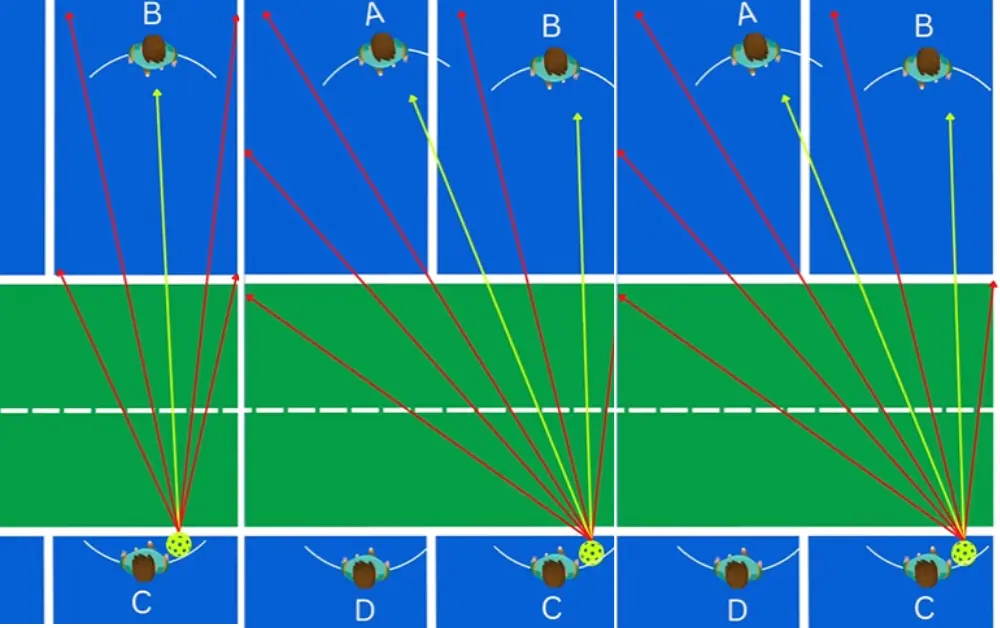
Superior shot location separates the good players from the greats. Analyze your shot patterns and work on deliberately striking balls as shown in the above visuals. Focus on:
- Cross-court to pull opponents wide
- Down the line to open up the court
- Behind players to draw them backwards
Also, train for executing:
- Baseline drives that force weak return blocks
- Sharp-angled winners from kitchen line placements
Adopt a tactical mindset focused on moving opponents out of position and then capitalizing on winners.
Improving Balance and Position in the Green Zone
The “green zone” is the area near the net, also known as the non-volley zone. Dominating this area is crucial for success in pickleball. To improve your balance and position:
- Practice moving forward and backwards smoothly, maintaining a low center of gravity.
- Work on your split step, a small hop that prepares you to move in any direction quickly.
- Focus on positioning yourself so that you can reach any shot without overextending, keeping your paddle ready for quick volleys.
Dinking Strategies
Dinking is a soft shot that lands in the opponent’s non-volley zone. It’s a strategic move that can set up winning shots. To enhance your dinking strategies:
- Practice different types of dinks, such as cross-court, straight-ahead, and backspin dinks.
- Aim to place your dinks just over the net and into difficult spots for your opponent to reach.
- Use dinks to move your opponent around the court, creating openings for more aggressive shots.
Maintaining an Athletic Stance
An athletic stance is essential for quick movements and effective shot-making. To maintain a strong stance:
- Keep your knees bent and your weight balanced on the balls of your feet.
- Stay low and ready to move, with your paddle in front of you at all times.
- Practice transitioning quickly from your athletic stance to full swing, ensuring that you’re always in a position to make a strong shot.
Conclusion
self-coaching in pickleball is a great way to get better at the game. By working on basic moves, key skills, and some advanced tips as we shared above, you can take your play to the next level. Furthermore, keep practicing and don’t give up. Enjoy your journey to becoming a better player and have fun with the game!

